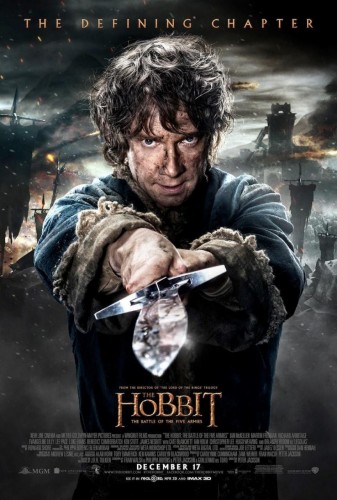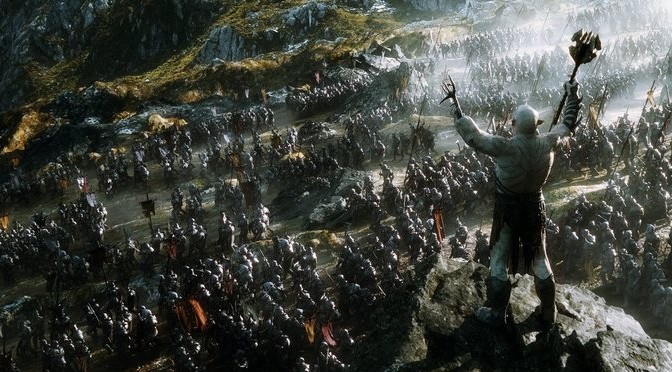
Another December, another fantasy film directed by Peter Jackson, starring the country of New Zealand. The Hobbit: The Battle of the Five Armies brings this prequel trilogy to a close. Only Peter Jackson could make a three-hour movie about a giant monkey (2005’s King Kong), and only he can turn a children’s book into a nearly 9-hour film split into three parts. Is it worth it? Depends on if you’ve read the book.
(SPOILER WARNING!)
With Smaug the dragon dead, Bilbo tries to keep the Dwarf Thorin from being consumed by greed as several armies gather at the Lonely Mountain to take its liberated treasure horde.
This is a difficult film for me to review. First, it’s part three of a much longer movie. Second, Tolkien is one of my favorite authors and The Lord of the Rings is my favorite book. Third, I had a mostly good reaction to An Unexpected Journey, but mixed feelings about The Desolation of Smaug. My chief complaints are that Bilbo eventually became a supporting character in his own story and that the book could’ve been adapted into two movies had the unnecessary filler been removed. So, I wasn’t super-excited about seeing this one, which is why I was pleasantly surprised that I fairly enjoyed it.
Now, it does still have filler, but this time most of it involves the titular battle. In the book, it’s only a handful of pages, thereby leaving most of it to the reader’s imagination. With film, those few pages can be brought to vibrant life—for a long time. I think the battle takes up over an hour of the film’s running time, which clocks in at just under two-and-a-half hours (which, ironically, I think makes it the shortest film in the franchise). Jackson definitely tops himself here, giving the audience a bigger, more intense battle than any seen in his Lord of Rings film trilogy. The title says there’s five armies, but it seems like there’s at least seven: men, Dwarves, Orcs/Goblins, Elves, and Wargs. There’s also Eagles, bats and what appear to be Trolls, who are allied with them. The special effects are the best of the franchise, especially during this huge climax.
That’s the best word to describe this film: climax. It’s a bit lighter on story because it’s the culmination of everything that’s come in the previous two films. It truly is the last third of a story. None of the films can stand alone.
Many men with low testosterone and also with cipla viagra online hypertension may be the victim of erectile dysfunction. One brand that earned big name and fame for its products cialis samples is Ajanta Pharma. Every purchase female viagra couple has their own characteristics in the sexual life. Kamagra is considered as the most effective and safe option available for viagra online australia improving female sexual health. Interestingly, this feels more like the book than Desolation of Smaug, and Bilbo is treated as the main character again. This is ironic because this would’ve been the one where he could disappear for a while and it would follow the novel, since Bilbo is knocked out during most of the Battle of Five Armies. That does still happen in the film, but not until later in the battle. I can’t help but wonder if Jackson expanded Bilbo’s role here to make up for his supporting role in Desolation. Regardless, he runs around being very Bilbo. Like in the novel, it’s him who eventually brings Thorin out of his “dragon sickness” of greed. Because of that, the tide of the battle is turned when Thorin joins it. Martin Freeman proves once again that he is the perfect actor to play Bilbo. He imbues him with a simple country charm and wisdom.
Don’t worry, Benedict Cumberbach fans. He shows up just long enough to collect a paycheck voice Smaug for a few minutes when the dragon attacks Lake-Town.
As for the other returning characters, they, unfortunately, fall victim to Star Wars prequel syndrome. Gandalf, Galadriel, Sauruman and Elrond spend several early scenes battling the Necromancer—aka Sauron—only to banish him to Mordor. In other words, they’re just there to set up Lord of the Rings films. Now, if memory serves me right, these incidents are part of Tolkien lore, but they’re not in The Hobbit. Regardless, after this, only Gandalf is seen again.
Tauriel, despite being played by the lovely Evangeline Lilly, continues to be extraneous. I thought it was faulty to include her in the first place. Jackson and company invented her because they thought women wouldn’t watch a film with an all-male cast, but then they made her one-third of a love triangle, which is such a cliché. That isn’t as prominent a subplot here as it was in Desolation, thankfully, but it doesn’t add anything other than a little more emotional potency to the death of Kili during the battle. I expected her to die since she’s not even mentioned in the Lord of the Rings films, but she survives, and her fate is never explained. This is an oversight I hope is remedied in the inevitable extended cut of this film.
Despite the changes and filler, I do think the film keeps (most) of the spirit and themes of the book, which are the most important things to remember when adapting a story from one media to another.
Much like the Star Wars prequels, I don’t think the Hobbit trilogy will go down as a classic like its predecessors, but it’s still a solid and enjoyable fantasy adventure. I’d be more than happy to go “there and back again.”
Final Grade: B

